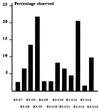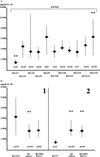Interleukin 10 secretion in relation to human IL-10 locus haplotypes
- PMID: 9689103
- PMCID: PMC21361
- DOI: 10.1073/pnas.95.16.9465
Interleukin 10 secretion in relation to human IL-10 locus haplotypes
Abstract
Stimulation of human blood cultures with bacterial lipopolysaccharide (LPS) shows large inter-individual variation in interleukin 10 (IL-10) secretion, which has been shown to have a genetic component of over 70%. Alleles at two microsatellite loci in the 4 kb immediately upstream of the human IL-10 transcription initiation site in 132 individuals from 56 Dutch families were defined and assigned as haplotypes. LPS-induced IL-10 secretion was measured by ELISA and related to the IL-10 promoter haplotypes present in 78 unrelated individuals obtained from these families. Analysis showed that LPS-induced IL-10 secretion from unrelated individuals varied with IL-10 promoter haplotypes (P = 0.024; Kruskal-Wallis test). Two observations were made in relation to secreted IL-10 levels and promoter haplotypes; first, those haplotypes containing the allele IL10.R3 were associated with lower IL-10 secretion than haplotypes containing any other IL10.R allele. Second, the haplotype IL10.R2/IL10.G14 was associated with highest IL-10 secretion overall, whereas the haplotype IL10.R3/IL10.G7 was associated with lowest IL-10 secretion. These data demonstrate that the ability to secrete IL-10 can vary in man according to the genetic composition of the IL-10 locus.
Figures



References
-
- Mosmann T R. Adv Immunol. 1994;56:1–26. - PubMed
-
- Wanidworanun C, Strober W. J Immunol. 1993;151:6853–6861. - PubMed
-
- Llorente L, Richaud-Patin Y, Fior R, Alcocer-Varela J, Wijdnes J, Morel-Fourrier B, Galanaud P, Emilie P. Arthritis Rheum. 1994;37:1647–1655. - PubMed
-
- Cash J J, Splawski J B, Thomas R, McFarlin J F, Schulze-Koops H, Davis L S, Fujita K, Lipsky P E. Arthritis Rheum. 1995;38:96–104. - PubMed
Publication types
MeSH terms
Substances
LinkOut - more resources
Full Text Sources
Molecular Biology Databases

